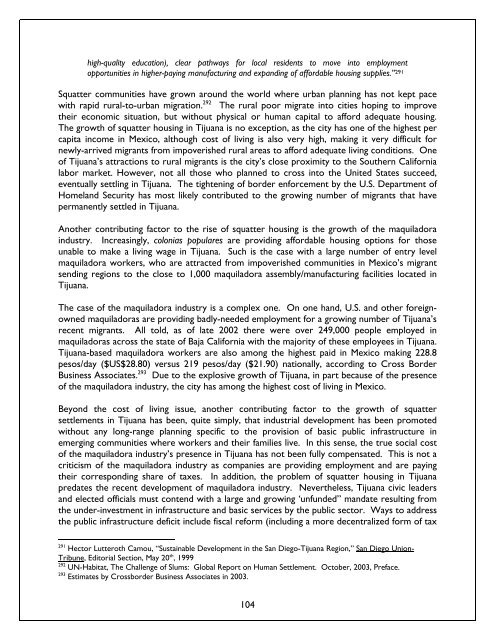Blurred Borders - International Community Foundation
Blurred Borders - International Community Foundation
Blurred Borders - International Community Foundation
Create successful ePaper yourself
Turn your PDF publications into a flip-book with our unique Google optimized e-Paper software.
high-quality education), clear pathways for local residents to move into employment<br />
opportunities in higher-paying manufacturing and expanding of affordable housing supplies.” 291<br />
Squatter communities have grown around the world where urban planning has not kept pace<br />
with rapid rural-to-urban migration. 292 The rural poor migrate into cities hoping to improve<br />
their economic situation, but without physical or human capital to afford adequate housing.<br />
The growth of squatter housing in Tijuana is no exception, as the city has one of the highest per<br />
capita income in Mexico, although cost of living is also very high, making it very difficult for<br />
newly-arrived migrants from impoverished rural areas to afford adequate living conditions. One<br />
of Tijuana’s attractions to rural migrants is the city’s close proximity to the Southern California<br />
labor market. However, not all those who planned to cross into the United States succeed,<br />
eventually settling in Tijuana. The tightening of border enforcement by the U.S. Department of<br />
Homeland Security has most likely contributed to the growing number of migrants that have<br />
permanently settled in Tijuana.<br />
Another contributing factor to the rise of squatter housing is the growth of the maquiladora<br />
industry. Increasingly, colonias populares are providing affordable housing options for those<br />
unable to make a living wage in Tijuana. Such is the case with a large number of entry level<br />
maquiladora workers, who are attracted from impoverished communities in Mexico’s migrant<br />
sending regions to the close to 1,000 maquiladora assembly/manufacturing facilities located in<br />
Tijuana.<br />
The case of the maquiladora industry is a complex one. On one hand, U.S. and other foreignowned<br />
maquiladoras are providing badly-needed employment for a growing number of Tijuana’s<br />
recent migrants. All told, as of late 2002 there were over 249,000 people employed in<br />
maquiladoras across the state of Baja California with the majority of these employees in Tijuana.<br />
Tijuana-based maquiladora workers are also among the highest paid in Mexico making 228.8<br />
pesos/day ($US$28.80) versus 219 pesos/day ($21.90) nationally, according to Cross Border<br />
Business Associates. 293 Due to the explosive growth of Tijuana, in part because of the presence<br />
of the maquiladora industry, the city has among the highest cost of living in Mexico.<br />
Beyond the cost of living issue, another contributing factor to the growth of squatter<br />
settlements in Tijuana has been, quite simply, that industrial development has been promoted<br />
without any long-range planning specific to the provision of basic public infrastructure in<br />
emerging communities where workers and their families live. In this sense, the true social cost<br />
of the maquiladora industry’s presence in Tijuana has not been fully compensated. This is not a<br />
criticism of the maquiladora industry as companies are providing employment and are paying<br />
their corresponding share of taxes. In addition, the problem of squatter housing in Tijuana<br />
predates the recent development of maquiladora industry. Nevertheless, Tijuana civic leaders<br />
and elected officials must contend with a large and growing ‘unfunded” mandate resulting from<br />
the under-investment in infrastructure and basic services by the public sector. Ways to address<br />
the public infrastructure deficit include fiscal reform (including a more decentralized form of tax<br />
291<br />
Hector Lutteroth Camou, “Sustainable Development in the San Diego-Tijuana Region,” San Diego Union-<br />
Tribune, Editorial Section, May 20 th , 1999<br />
292<br />
UN-Habitat, The Challenge of Slums: Global Report on Human Settlement. October, 2003, Preface.<br />
293<br />
Estimates by Crossborder Business Associates in 2003.<br />
104















